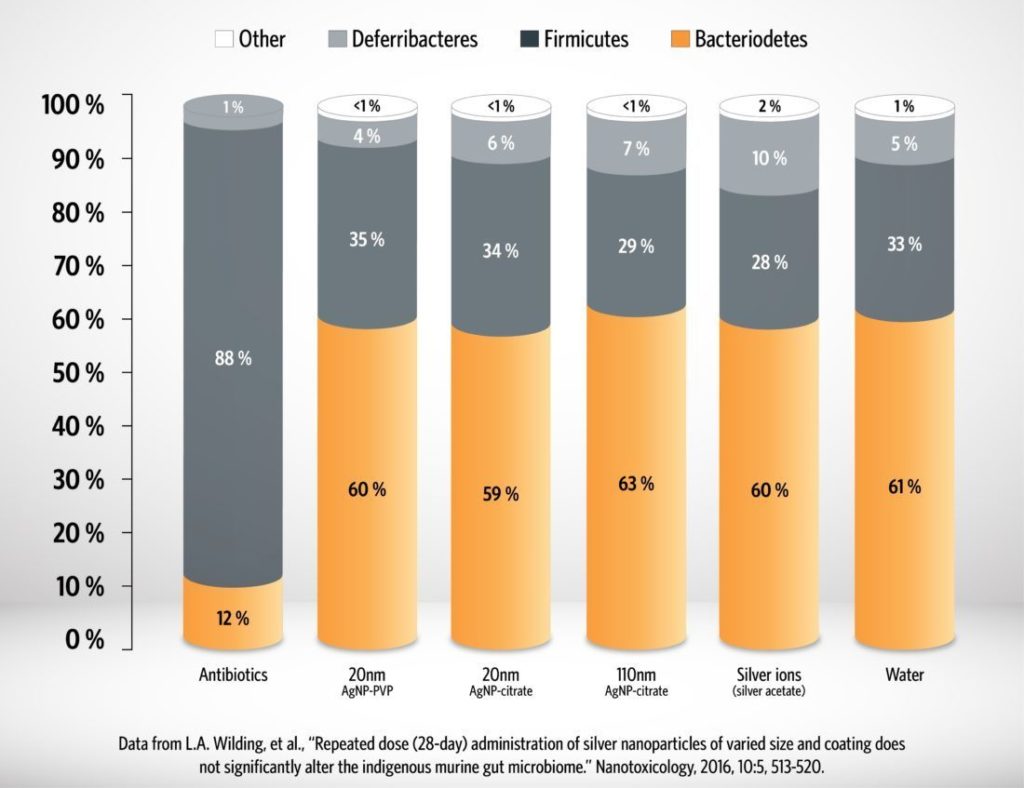The gut-brain axis plays an important role in our overall health and well-being, and maintaining the appropriate microflora balance in the gut microbiome is a common focus in overall health care strategies.
Thousands of different species of bacteria typically comprise the diversity of a gut microbiome.1 There are many unique “fingerprint” microbiomes across the population.2 Compared to the number of cells in the human body, there are as many3 bacterial cells to ten times as many4 in the microbiome, with the precise number being a decades-long debate in the literature.
It is well known that potential sources of disruption to the gut microbiome’s diversity of species range from changes in diet to prescription antibiotics to environmental contaminants. The disruption to the natural balance of an individual’s particular diversity of microbial species is what leads to undesirable effects, as is seen for example in antibiotic-associated diarrhea.5 Therefore, it is wise to raise the question about silver’s potential impact on the gut microbiome’s diversity. However, typically when concerns are raised about this topic, the question is commonly mis-phrased as “Does silver kill the good bacteria in my gut?” The more appropriate question is, “Does silver alter the natural diversity of gut microbiome species?”
The peer-reviewed literature in 2016 studied this exact question. The title of the article by Wilding, et al., says it clearly, “Repeated dose (28-day) administration of silver nanoparticles of varied size and coating does not significantly alter the indigenous murine gut microbiome.”6
In 2019, Li, et al., reviewed the scientific literature in an article titled “Review of the effects of silver nanoparticle exposure on gut bacteria.”[REF A] There, the authors reported that four out of six mammalian studies showed no significant disruption to the diversity of the gut microbiome after silver exposures significantly greater than the daily safety guidance issued by WHO and EPA, which provides strong evidence replicating the results first reported by Wilding.
This is where the frontier of knowledge is in the research community, and it is gaining interest as more researchers are studying important scientific questions about silver and the gut microbiome.
Conclusions
The authors concluded that silver in any form studied did not disrupt the diversity of the gut microbiome. Unsurprisingly, the natural diversity of the gut microbiome was tremendously disrupted by the broad-spectrum antibiotic cefoperazone.
It is important to note the silver concentrations used were 2,000 X the EPA and WHO safety guideline of 5 µg/kg b.w./day.7, 8 Changing the size of the nanoparticles from 20 nm to 110 nm diameter did not alter the lack of disruption to the microbiome’s diversity, nor did changing the surface coating from citrate to the polymer PVP. Additionally, the form of silver being either ionic or metal particle showed no impact on the microbial diversity.
In summary, silver does not disrupt the natural diversity gut microbiome, adding to the body of evidence demonstrating how silver works in a natural balance with the entire body supporting immune health.
Note that this study did not evaluate Natural Immunogenics (NIC) products and that this summary is provided to the reader for informational purposes only. NIC’s products are marketed as Dietary Supplements in the USA and, by law, are not authorized to make any claim that they can treat, cure, mitigate or prevent any disease. Further, NIC is not comparing its products to FDA approved antibiotics.
Argentyn 23® Bio-Active Silver HydrosolTM contains just two ingredients: 99.999% pure silver and water that meets USP-NF standards for pharmaceutical-grade purified water. It delivers only naturally occurring silver nanoparticles and bio-active silver ions, and is stored in amber glass to protect its purity.
Argentyn 23 Bio-Active Silver Hydrosol is free of proteins, salts, and other compounds and therefore poses no health hazard when used as directed.* However other colloidal silvers may contain these impurities therefore decreasing efficacy and increasing the risk of causing Argyria.
Previous: Safety & Toxicity
Next: Product Comparison Tool
References
- Shreiner AB, Kao JY, et al., The gut microbiome in health and in disease. Current opinion in gastroenterology, 2015. 31(1): p. 69-75.
- Franzosa EA, Huang K, et al., Identifying personal microbiomes using metagenomic codes. Proceedings of the National Academy of Sciences, 2015. 112(22): p. E2930-E2938.
- Sender R, Fuchs S, et al., Revised estimates for the number of human and bacteria cells in the body. PLOS Biology, 2016. 14(8): p. e1002533.
- Savage DC, Microbial ecology of the gastrointestinal tract. Annual Review of Microbiology, 1977. 31(1): p. 107-133.
- Barbut F,Meynard JL, Managing antibiotic associated diarrhoea : Probiotics may help in prevention. BMJ : British Medical Journal, 2002. 324(7350): p. 1345-1346.
- Wilding LA, Bassis CM, et al., Repeated dose (28-day) administration of silver nanoparticles of varied size and coating does not significantly alter the indigenous murine gut microbiome. Nanotoxicology, 2016. 10(5): p. 513-20.
- Organization WH, Health criteria and other supporting information. Guidelines for drinking-water quality, 2nd ed. Vol. 2. 1996, Geneva.
- Agency USEP, Silver; casrn 7440-22-4: Integrated risk information system (iris) chemical assessment summary, US EPA NCfEA, Editor. 1989, US EPA.


